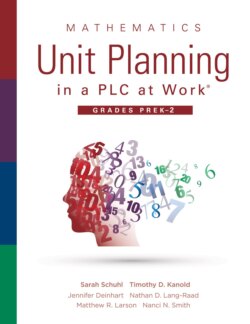Читать книгу Mathematics Unit Planning in a PLC at Work®, Grades PreK-2 - Timothy D. Kanold - Страница 12
На сайте Литреса книга снята с продажи.
Mathematics Unit Planner
ОглавлениеOnce your team determines the mathematics units for your grade level (detailing the standards and time line for each unit) for the year, your collaborative team can plan for student learning on a unit-by-unit basis (see figure 1.2; Kanold & Schuhl, 2020).
The Mathematics Unit Planner in figure 1.2 provides a template your team can use as you develop a shared understanding of what students are expected to learn in each unit of study. The numbered sections in the Mathematics Unit Planner correspond with the seven elements of unit planning. Throughout this book, you will see numbered headings that correspond with these seven areas. (Find completed examples of unit planners for preK in figure 3.12 [page 58], kindergarten in figure 4.11 [page 79], first grade in figure 5.11 [page 105], and second grade in figure 6.11 [page 129].)
Once the elements of the Mathematics Unit Planner (see figure 1.2) are complete, your team can use the information to plan for common assessments and daily lesson design (see Mathematics Assessment and Intervention in a PLC at Work [Kanold, Schuhl, et al., 2018] and Mathematics Instruction and Tasks in a PLC at Work [Kanold, Kanold-McIntyre, et al., 2018]). Additionally, you and your collaborative team can reference the unit planner for each successive unit in the year and from one year to the next as your team continues to deepen its own understanding of the required student learning.
In Principles to Actions, the National Council of Teachers of Mathematics (NCTM, 2014a) shares, “Effective mathematics teaching begins with a shared understanding among teachers of the mathematics that students are learning and how this mathematics develops along learning progressions” (p. 12). Therefore, before diving into each individual unit plan for the year, as a team, first consider the mathematical content students are learning in your grade. Additionally, make sense of the mathematical content trajectories, or progressions, that students are learning across your preK–2 band.
